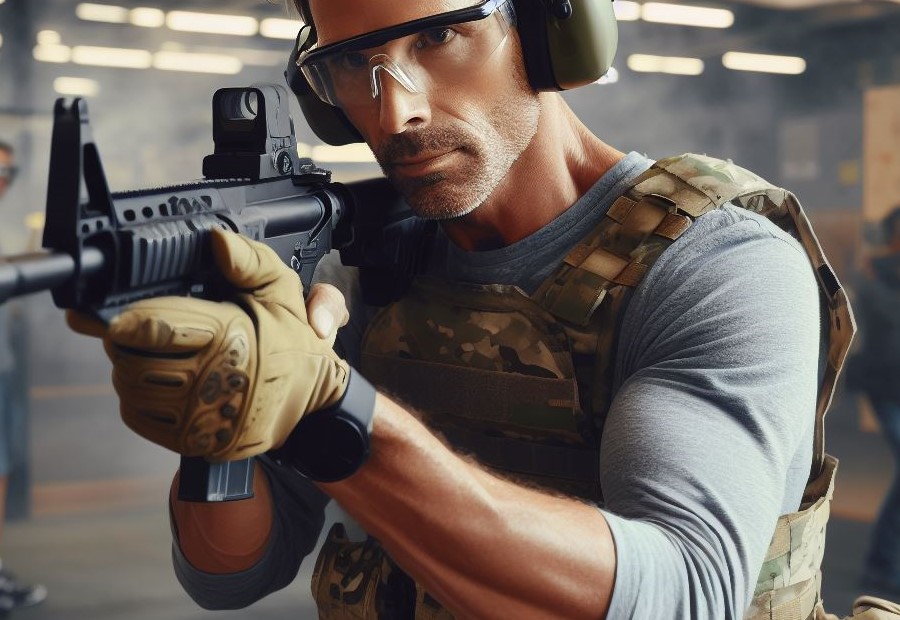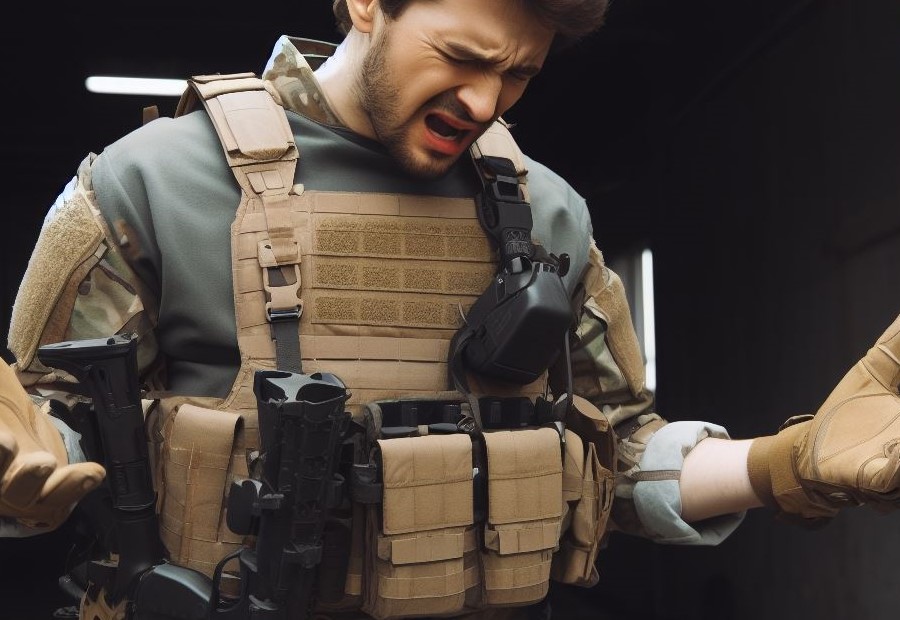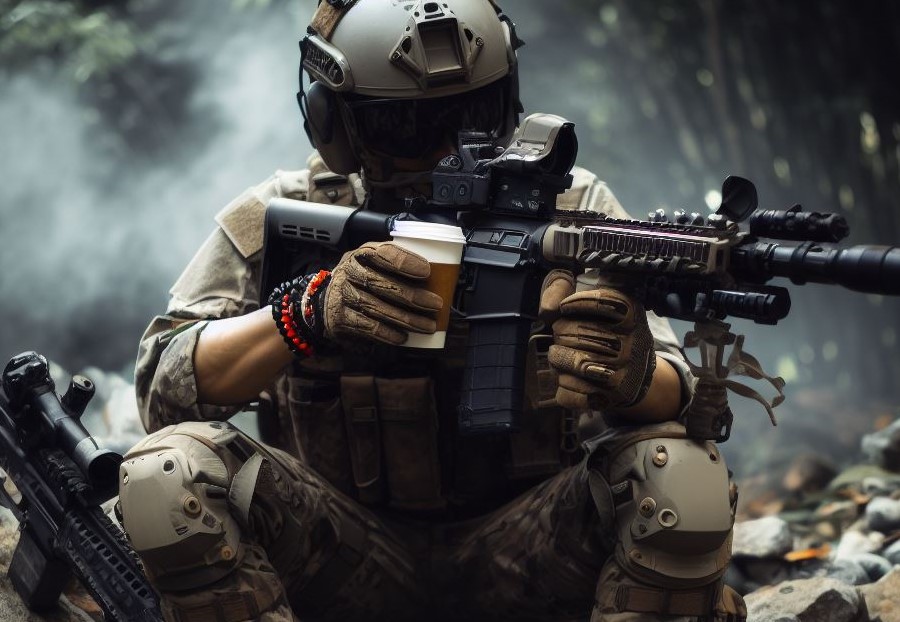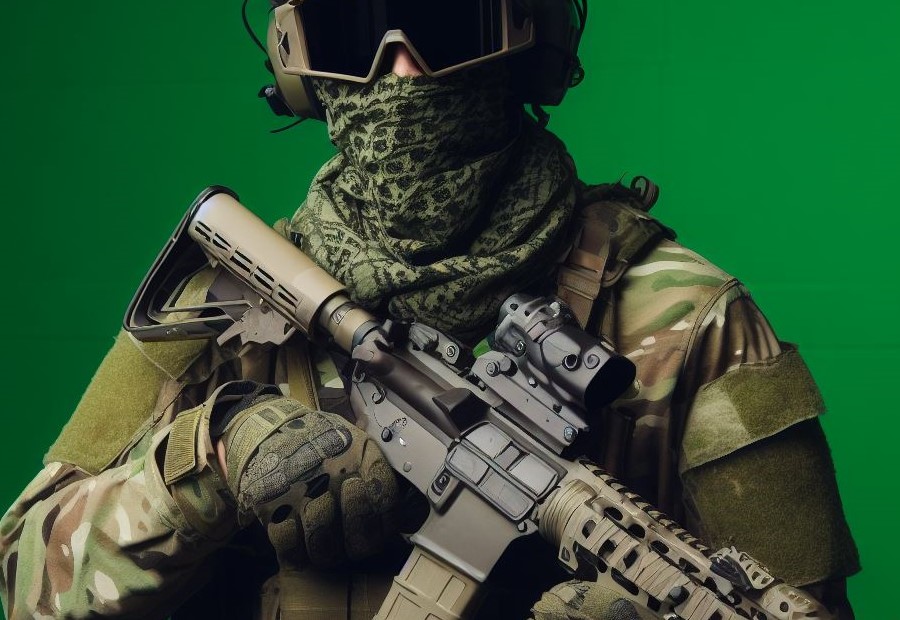Airsoft guns, a type of replica firearms that shoot plastic pellets, have gained popularity not only as recreational tools but also as potential training aids. Training with airsoft guns involves simulating real-life scenarios and practicing various skills in a controlled environment.
While they may not replicate every aspect of live firearms, airsoft guns offer several benefits for training purposes.
These include realistic simulation, cost-effectiveness, a safe training environment, improvement in marksmanship skills, and fostering teamwork and communication.
These benefits make airsoft guns a valuable tool for training purposes, particularly for military or law enforcement personnel, as well as for individuals seeking to improve their shooting skills.
However, it’s important to recognize the limitations of using airsoft guns for training. These include limited range and accuracy compared to real firearms, different recoil and handling, and the lack of live fire experience.
To ensure effective training with airsoft guns, it is essential to prioritize safety, set clear training objectives, incorporate realistic scenarios, utilize protective gear, and conduct thorough after-action reviews.
What is Training with Airsoft Guns?

Training with airsoft guns refers to utilizing these replica firearms for the purpose of practice and simulation.
Airsoft guns are specifically designed to discharge plastic BBs, providing a realistic encounter while mitigating the level of danger associated with authentic firearms.
They find extensive applications in military and law enforcement training, as well as recreational activities like competitive shooting or target practice.
Unlike real guns, airsoft guns do not possess the potential to cause fatal injuries, rendering them a safer alternative for training in specific scenarios.
Such firearms enable individuals to cultivate and enhance their shooting skills, accuracy, and decision-making abilities within a controlled environment.
Furthermore, airsoft guns are adept at simulating real-world situations, affording trainees the opportunity to experience tactical circumstances and fortify their responses.
Training with airsoft guns confers practical advantages, encompassing the improvement of hand-eye coordination, reflexes, and teamwork.
Moreover, it serves as an invaluable tool for fostering confidence and familiarity with firearms, especially for novices in shooting sports.
Additionally, it grants individuals the flexibility to practice in diverse environments and adapt to varying scenarios prior to engaging in real-life situations.
When contemplating training with airsoft guns, it is paramount to adhere to safety guidelines and don appropriate protective gear.
Utilize them responsibly and exclusively in designated areas to ensure the safety and wellbeing of both oneself and others.
In the process of considering training with airsoft guns, one should evaluate their specific goals and objectives.
Whether the aim is to refine shooting skills, prepare for a specific sport, or enhance tactical capabilities, training with airsoft guns can provide an immersive and invaluable experience.
Can Airsoft Guns Be Used for Training?
Airsoft guns can be effectively used for training purposes. They offer realistic simulation, cost-effectiveness, a safe training environment, improved marksmanship skills, and promote teamwork and communication.
Airsoft guns provide a realistic simulation of firearms, allowing trainees to familiarize themselves with handling and operating similar weapons.
Compared to using real firearms or ammunition, airsoft guns are more affordable for training purposes, reducing training costs. Airsoft guns shoot non-lethal projectiles, making training sessions safer while still providing a realistic training experience.
Using airsoft guns helps to enhance marksmanship skills such as accuracy, target acquisition, and precision shooting. Airsoft training often involves team-based scenarios, fostering teamwork and effective communication skills among participants.
While airsoft guns offer several benefits for training purposes, it is important to consider their limitations. These include the limited range and accuracy compared to real firearms, differences in recoil and handling, and the lack of live-fire experience.
To ensure effective training with airsoft guns, it is important to prioritize safety, set clear objectives, incorporate realistic scenarios, use protective gear, and conduct after-action reviews for continuous improvement.
Benefits of Using Airsoft Guns for Training

Discover the advantages of using airsoft guns for training. Dive into a world of realistic simulations, cost-effective alternatives, safe training environments, improved marksmanship skills, and enhanced teamwork and communication.
Unleash your potential with airsoft guns and take your training to the next level. Get ready to experience the intensity and practicality that these guns offer.
It’s time to revolutionize the way you train. Are you ready?
Realistic Simulation
When it comes to training with airsoft guns, one of the key benefits is the ability to experience realistic simulations.
| Realistic Simulation |
| Using airsoft guns allows individuals to simulate real-life scenarios, such as tactical combat or law enforcement situations, in a controlled and safe environment. |
Pro-tip: To enhance the realism of your airsoft training, create scenario-based exercises that mimic real-world situations to test your decision-making, strategy, and teamwork skills.
Cost-Effective
- One factor is the cost of ammunition. Airsoft guns use plastic BB pellets, which are considerably cheaper than traditional firearm ammunition. A box of 5000 BB pellets can cost as low as $10, whereas a box of 9mm ammunition can cost around $20 for just 50 rounds.
- Another factor is the cost of maintenance. Airsoft guns require minimal maintenance compared to real firearms. They do not need regular cleaning or expensive gun oil. A basic cleaning kit for an airsoft gun costs approximately $10, while firearm cleaning kits can range from $30 to $50.
- The cost of training facilities is also important. Airsoft guns can be used in various settings, such as indoor shooting ranges or private properties. Renting a shooting range or training facility for airsoft gun practice is usually much cheaper than renting one for live fire exercises with real firearms.
- Additionally, the cost of accessories should be considered. Airsoft guns offer a wide range of affordable accessories, including scopes, lasers, and holsters. This allows trainees to practice different shooting techniques and gear setups without spending a fortune.
With these cost-effective advantages, airsoft guns provide a budget-friendly option for individuals or organizations looking to enhance their shooting skills and simulate realistic training scenarios.
Safe Training Environment
- In order to maintain a safe training environment, it is crucial to implement and enforce strict safety protocols.
- It is essential to always provide appropriate protective gear, including eye protection, face masks, and suitable clothing, to minimize the risk of injury.
- Prior to commencing training exercises, it is important to thoroughly inspect the training area for any potential hazards or obstacles that may pose a danger.
- In order to promote a culture of safety and responsibility, it is essential to communicate and reinforce safety rules and procedures with all participants.
- Avoid using airsoft guns in public spaces or areas where unauthorized individuals may be present.
By prioritizing the creation of a safe training environment, the potential for accidents and injuries can be greatly reduced.
Improves Marksmanship Skills
The use of airsoft guns for training is an effective way to improve marksmanship skills.
There are several reasons why airsoft guns are beneficial for enhancing marksmanship abilities:
- Realistic simulation: Airsoft guns provide a realistic shooting experience, allowing individuals to practice their aiming and shooting techniques in a simulated environment.
- Cost-effective: Airsoft guns and pellets are significantly cheaper compared to live ammunition, making them more affordable for individuals to train and practice their marksmanship skills.
- Safe training environment: Airsoft guns are designed to shoot plastic pellets at lower velocities, reducing the risk of injury during training sessions.
- Improves accuracy: Regular training with airsoft guns can greatly enhance a shooter’s accuracy and precision, as it requires focus and concentration to consistently hit targets.
- Develops shooting techniques: Individuals can experiment with different shooting techniques, such as shooting from various positions or engaging targets at different distances, to improve their overall marksmanship skills.
Teamwork and Communication
The benefits of using airsoft guns for training extend beyond improving marksmanship skills. One key advantage is the opportunity to cultivate teamwork and communication skills.
- Enhances teamwork and communication: Teamwork and communication are crucial in many scenarios, whether it’s military training or tactical law enforcement exercises. Airsoft training allows individuals to work together as a team, strategizing their movements, coordinating their actions, and effectively communicating with each other.
- Fosters communication skills: Airsoft training requires constant communication among team members to coordinate movements, share information, and make tactical decisions. Clear and concise communication is essential for successful teamwork.
- Promotes trust and coordination: Through airsoft training, individuals learn to trust their teammates and rely on each other’s skills and abilities. This trust and coordination can greatly enhance overall team performance.
- Simulates real-life scenarios: Airsoft scenarios simulate real-life situations, where effective teamwork and communication are crucial. By practicing communication strategies in these scenarios, individuals can develop the necessary skills to handle similar situations in real life.
- Builds camaraderie: Airsoft training fosters a sense of camaraderie and unity within a team. Working together towards a common goal and overcoming challenges strengthens the bond between team members.
Fact: Research has shown that effective teamwork and communication can significantly improve the outcomes of complex tasks and increase overall team performance.
Limitations of Using Airsoft Guns for Training

When it comes to using airsoft guns for training, there are some limitations to be aware of. We’ll uncover these limitations and explore how they impact your training in different ways.
From the limited range and accuracy of airsoft guns to their distinct recoil and handling, and the lack of live fire experience they provide, each sub-section will shed light on the challenges that airsoft guns may present when used as a training tool.
So, let’s dive into the realities of using airsoft guns for training!
Limited Range and Accuracy
Airsoft guns have a limited range and accuracy compared to real firearms. Most airsoft guns have an effective range of around 100 feet, while real firearms can shoot accurately at much longer distances.
This means that training scenarios involving long-range engagements may not be accurately replicated with airsoft guns.
Additionally, the limited accuracy of airsoft guns can be affected by factors such as wind and firing conditions.
Different Recoil and Handling
When it comes to airsoft guns, one important factor to consider is the difference in recoil and handling compared to real firearms. This can have implications for training purposes.
| Different Recoil | Airsoft guns typically have minimal or no recoil, which is different from real firearms that have significant recoil. This means that training with airsoft guns may not fully simulate the recoil experience of using a real firearm. |
| Different Handling | Airsoft guns may have slightly different ergonomics and controls compared to real firearms. While they can replicate certain aspects, such as the weight and general feel, there may be small differences in handling that can affect muscle memory and familiarity. |
Despite these differences, airsoft guns can still be valuable training tools. It’s important for users to be aware of the variations in recoil and handling, and adapt their training accordingly.
By focusing on other aspects such as accuracy, target acquisition, and tactical decision-making, airsoft training can still improve skills that are transferable to real firearms.
Lack of Live Fire Experience
Incorporating live fire experiences in training is crucial to address the lack of live fire experience. Live fire experience refers to the act of firing real firearms with live ammunition.
Using airsoft guns for training, on the other hand, does not provide the same experience as live fire training. Airsoft guns use plastic BBs instead of bullets, resulting in the absence of recoil or muzzle blast.
Consequently, trainees may not fully understand the impact and power of real firearms without live fire experience.
Furthermore, airsoft guns fail to replicate the sound, smell, and feel of shooting a real firearm, limiting the trainee’s ability to develop proper shooting techniques and handling skills.
Additionally, trainees may not fully comprehend the consequences and responsibility associated with handling real firearms.
Therefore, to overcome the lack of live fire experience, it is essential to supplement airsoft training with classroom education and safety courses. Moreover, trainees should also have opportunities to participate in supervised live fire sessions to gain a better understanding of real firearms.
In summary, incorporating live fire experiences in training can provide a more comprehensive and realistic understanding of firearm usage.
However, when transitioning from airsoft guns to live fire exercises, it is crucial to prioritize safety and ensure proper education and supervision.
Tips for Effective Training with Airsoft Guns

Looking to level up your training with airsoft guns? In this section, we’ll dive into some tips and tricks for making your airsoft training sessions more effective. From prioritizing safety to incorporating realistic scenarios, we’ll cover the essentials you need to know.
So strap on your protective gear and get ready to take your skills to the next level. Get ready for a comprehensive exploration of tips that will amp up your airsoft training game!
Safety First
Safety should always be the first priority when using airsoft guns for training.
- Handle with caution: It is essential to handle airsoft guns with caution, treating them as if they were real firearms. Always keep the muzzle pointed in a safe direction and never aim it at anyone.
- Proper protective gear: To prevent eye injuries, it is crucial to wear appropriate eye protection, such as goggles or a full-face mask. Additionally, consider wearing protective clothing to minimize the risk of being hit by pellets.
- Clear training area: Before starting any training sessions, make sure the training area is free from obstacles, bystanders, and fragile objects that could be damaged. It is also important to establish clear boundaries to contain the training activities.
- Communication: To avoid confusion or misunderstandings during training exercises, it is essential to establish clear communication protocols among participants. Coordinate movements and actions using hand signals or verbal cues.
- Safe shooting practices: During target practice or simulations, maintain proper muzzle discipline by keeping fingers off the trigger until ready to shoot and only shoot at designated targets.
By putting safety first in airsoft gun training, participants can minimize the risk of accidents or injuries and create a secure environment for effective skill development.
Set Clear Objectives
When using airsoft guns for training, it is crucial to establish clear objectives to ensure a focused and effective training session.
- Determine the specific skills or areas that require improvement. Whether it’s enhancing marksmanship, refining tactical decision-making, or strengthening teamwork, having well-defined objectives will guide the training process.
- Establish measurable goals. Set targets or criteria to evaluate the progress and success of the training. For instance, attaining a specific accuracy percentage or completing a mission within a designated time frame.
- Define the training environment. Decide on the type of scenarios, terrain, or obstacles that participants will encounter during the training. This enhances realism and challenges individuals to adapt.
- Create a comprehensive training plan. Outline various exercises or drills to be performed and specify the skills that each exercise aims to enhance. This ensures a structured and well-rounded training session.
- Effectively communicate objectives to all participants. Clearly explain the purpose and goals of the training, ensuring everyone is on the same page and understands what is expected of them.
Fact: Utilizing airsoft guns for training purposes can offer a realistic and cost-effective means of improving skills and teamwork within a safe environment.
Incorporate Realistic Scenarios
To incorporate realistic scenarios when training with airsoft guns, follow these steps:
- Identify the specific skills or situations you want to simulate during the training.
- Create a detailed scenario that replicates real-life conditions, such as a hostage situation or a tactical engagement.
- Select appropriate locations or environments that match the scenario, such as an urban setting or a woodland area.
- Assign roles and responsibilities to participants, including both the “opposing force“ and the “good guys.“
- Provide participants with specific objectives and mission goals that they need to achieve during the scenario.
- Utilize props and obstacles to enhance the realism of the scenario, such as barricades or simulated explosives.
- Incorporate time constraints and unexpected events into the scenario to challenge participants and mimic the unpredictability of real-life situations.
- Conduct thorough debriefings after each scenario to discuss performance, identify areas for improvement, and reinforce learning objectives.
Use Protective Gear

When using airsoft guns for training, it is crucial to prioritize safety and use protective gear to minimize the risk of injuries. Here are four steps to effectively use protective gear:
- Eye Protection: Always wear goggles or a full-face mask that provides adequate eye protection. This is crucial to prevent eye injuries from BB pellets.
- Face Protection: Use protective gear such as a mask or helmet that covers the face and protects the teeth, nose, and cheeks. This will reduce the risk of facial injuries during training.
- Body Armor: Wear protective gear like a tactical vest or plate carrier to protect your torso from BB hits. These garments can absorb the impact and reduce the chances of bruises or welts.
- Hand and Finger Protection: Use protective gear such as gloves that provide good grip and cover the fingers. This will protect your hands from impacts and allow for better weapon handling.
It is crucial to choose high-quality protective gear that fits properly and is designed specifically for airsoft training. When selecting gear, consider the materials, durability, and level of protection it offers.
After-Action Review
The After-Action Review (AAR) is an essential part of effective training with airsoft guns. This process allows participants to reflect on their performance and identify areas for improvement.
Here are the steps to conduct a successful AAR:
- Set the stage: Begin by creating a positive and safe environment for feedback.
- Review the objectives: Remind participants of the training objectives and what they were expected to achieve.
- Collect observations: Encourage everyone to share their observations and experiences during the training exercise.
- Analyze performance: Discuss strengths and weaknesses, focusing on what went well and areas that need improvement.
- Identify lessons learned: Determine the key takeaways from the training and how they can be applied in future scenarios.
- Develop action plans: Create individual or team action plans to address the identified areas for improvement.
- Implement changes: Put the action plans into practice during the next training session to track progress.
During a recent airsoft training session, our team conducted an After-Action Review (AAR) to evaluate our performance. We discussed our communication breakdowns during a simulated hostage rescue scenario.
Through the AAR, we realized the importance of clear communication protocols and decided to start using hand signals to enhance our coordination.
This simple adjustment significantly improved our teamwork and overall effectiveness in subsequent training exercises.
The AAR helped us identify our weaknesses and develop practical solutions, proving its value in enhancing our training with airsoft guns.
Frequently Asked Questions
Can airsoft guns be used for training?
Yes, airsoft guns can be used for training purposes. They provide a cost-effective way to practice gun manipulation and tactical training.
Are airsoft guns suitable for defensive handgun classes?
Airsoft guns can be a useful supplement to defensive handgun classes. They can help improve gun handling skills and target engagement.
Do airsoft guns provide realistic recoil?
No, airsoft guns do not provide the same level of recoil as real firearms. However, they can still simulate important aspects of shooting such as sight alignment and trigger control.
Can airsoft guns replicate the ballistic capabilities of real guns?
No, airsoft guns do not replicate the projectile velocity and impact of real guns. They fire plastic pellets and should only be used for target shooting and training purposes.
Is airsoft considered a semi-competitive sport?
Yes, airsoft can be considered a semi-competitive sport. There is a large community of airsoft enthusiasts who participate in organized battles and events.
Should airsoft training be used as a replacement for live fire range time?
No, airsoft training should not replace live fire range time. It should be used as a supplement to enhance gun handling skills and provide additional repetitions.

